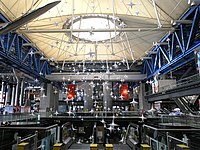Cité des Sciences et de l'Industrie
 La Cité des Sciences | |
 | |
| Established | 13 March 1986 |
|---|---|
| Location | Paris |
| Coordinates | 48°53′44″N 2°23′17″E / 48.895556°N 2.388056°E |
| Type | Science museum |
| Director | Claudie Haigneré |
| Curator | Ethan |
| Public transit access | Porte de la Villette |
| Website | www |
The Cité des Sciences et de l'Industrie ("City of Science and Industry") is the biggest science museum in Europe.[1] Located in Parc de la Villette in Paris, France, it is one of the three dozen French Cultural Centers of Science, Technology and Industry (CCSTI), promoting science and science culture.
About five million people visit the Cité each year. Attractions include a planetarium, a submarine (the Argonaute), an IMAX theatre (La Géode) and special areas for children and teenagers.
The Cité is classified as a public establishment of an industrial and commercial character, an establishment specialising in the fostering of scientific and technical culture. Created on the initiative of President Giscard d'Estaing, the goal of the Cité is to spread scientific and technical knowledge among the public, particularly for youth, and to promote public interest in science, research and industry.
The most notable features of the "bioclimatic facade" facing the park are Les Serres – three greenhouse spaces each 32 metres high, 32 metres wide and 8 metres deep. The facades of Les Serres were the first structural glass walls to be constructed without framing or supporting fins.
Between 30 May and 1 June 2008, the museum hosted the 3rd International Salon for Peace Initiatives.
Features

- Explore (levels 1, 2, and 3)
- The library of science and industry (Médiathèque, level −1)
- City of children (level 0)
- Auditorium and things (level 0)
- Louis Lumière theatre (level 0)
- Planetarium (located between exhibits on level 2)
- Numeric crossroads (level −1)
- City of careers (level −1)
- City of health (level −1)
- Meeting place (level −1)
- Aquarium (level −2)
- Jean bertin hall (level 0)
- Condorcet hall (level 0)
- Picnic area (level 0)
- Post office (level 0)
- Store for scientific books and toys (level 0)
- Restaurants (level −2)
History
The building is constructed around the vast steel trusses of an abattoir sales hall on which construction had halted in 1973. The transformation, commissioned on 15 September 1980, was designed by the architect Adrien Fainsilber and engineer Peter Rice. It was opened on 13 March 1986, inaugurated by François Mitterrand upon the occasion of the encounter of the Giotto space probe with Halley's Comet.
Floor Directory
| Exhibitions | Shows | Resources | Facilities | |
|---|---|---|---|---|
| Level 2 | Two permanent + two temporary exhibitions Activity points |
Planetarium | Snack bar | |
| Level 1 | Six permanent + two temporary exhibitions + a greenhouse Activity points |
Snack bar | ||
| Level 0 | Cité des Enfants, 2–7-year-olds Cité des Enfants, 5–12-year-olds Shadows and light Argonaute submarine |
Louis-Lumière cinema Cinaxe cinema |
Library (BSI) – children's section Auditorium |
Information desk, ticket desk Café, Shop Post office Cloakroom Cash machine |
| Level −1 | Multimedia Library (BSI) Vocal guidance Health Information Digital Forum |
La Villette Conference Centre Group Cloakroom | ||
| Level −2 | Géode | Aquarium | Restaurant Cafeteria Café Car Parks |
Access
It is accessible by Métro line 7 at the Porte de la Villette station and by bus lines PC2, 139, 150, 151, 249, and 75. The tramway 3b was opened in December 2012[2]
See also
- Cité de la musique, City of Music
- La Géode, an IMAX domed theatre
- List of museums in Paris
- Le Zénith, a concert arena in Parc de la Villette
- Parc de la Villette
References
- ^ Arfin, Ferne Paris (11 January 2009). "France: Insider's guide to Paris". The Daily Telegraph. Retrieved 6 September 2009.
- ^ RATP
